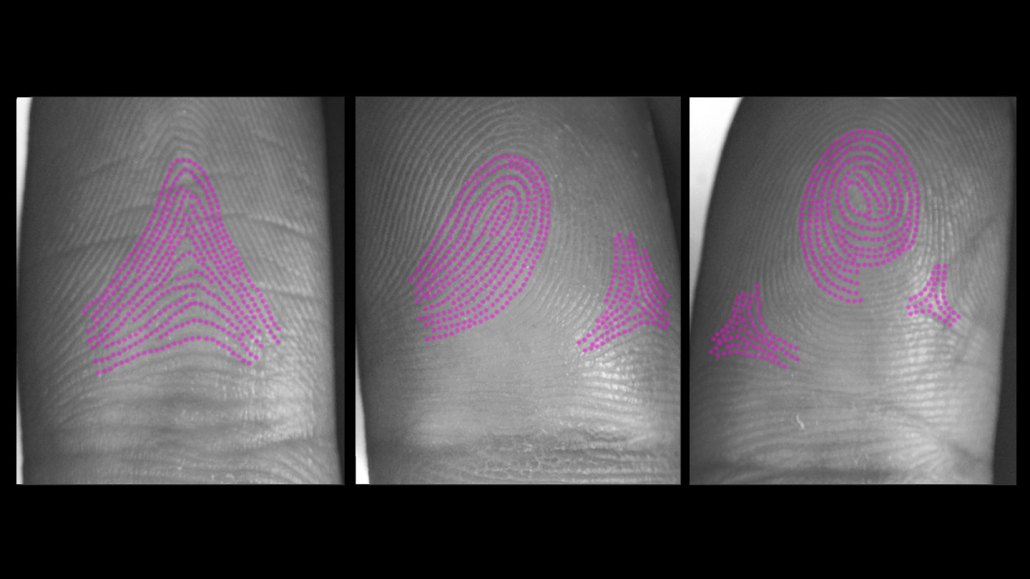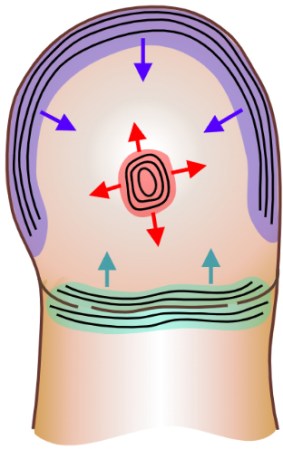How fingerprints form is no longer a mystery
A mathematical theory proposed in the 1950s helps explain the process

Three of the most common fingerprint shapes in humans (traced above in purple) are the arch (left), loop (center) and whorl (right).
J. Glover et al/Cell 2023
Share this:
- Share via email (Opens in new window) Email
- Click to share on Facebook (Opens in new window) Facebook
- Click to share on X (Opens in new window) X
- Click to share on Pinterest (Opens in new window) Pinterest
- Click to share on Reddit (Opens in new window) Reddit
- Share to Google Classroom (Opens in new window) Google Classroom
- Click to print (Opens in new window) Print
Scientists have finally closed the case on how fingerprints form.
Fingerprints are the looping, swirling stripes on the tips of your fingers. These raised ridges of skin develop before birth. They were known to expand out from three spots on each fingertip: under the nail, in the center of the finger pad and the crease of the joint closest to the tip. But no one knew what determined a fingerprint’s final pattern.
Now, scientists have found that three interacting molecules cause fingerprint ridges to form their signature stripes. The way those ridges spread from their starting points — and then merge — determines the overarching shape of a fingerprint.
Researchers described the work March 2 in Cell.
Unmasking the molecules behind fingerprints
Each person’s fingerprints are unique and last a lifetime. They have been used to identify individuals since the 1800s. But fingerprints are not just good for solving crimes. These ridges help humans and many animals that climb — such as koalas — hold onto objects and distinguish textures.
Scientists knew that fingerprint ridges start to form by growing down into the skin, like tiny trenches. Cells at the bottoms of the trenches quickly multiply, going deeper. But a few weeks later, the cells stop growing downward. Instead, they continue multiplying but push the skin upward, creating thickened bands of skin.
To find out what molecules might be involved in this growth, researchers turned to another skin structure that grows downward: a hair follicle. The team compared skin cells from developing hair follicles to those in budding fingerprint ridges. Molecules found in both places, the scientists figured, could be responsible for downward growth.
Both structures shared some types of signaling molecules. These chemical messengers pass information between cells. Both budding hair follicles and fingerprint ridges had molecules called WNT, EDAR and BMP.
Further experiments showed that WNT tells cells to multiply. That helps form ridges in the skin. It also instructs cells to produce EDAR, which in turn boosts WNT activity. BMP, on the other hand, stops these actions. This prevents the buildup of skin cells where there is a lot of BMP. So, places on the skin with more BMP become the valleys between fingerprint ridges.
Fingertip Turing patterns
Now that they knew WNT, EDAR and BMP were involved in forming fingerprint ridges, the researchers wondered how those molecules might lead to different print patterns. To find out, the team tweaked the levels of two of the molecules in mice. Mice don’t have fingerprints. But their toes have striped ridges in the skin similar to human prints.
“We turn a dial — or molecule — up and down, and we see the way the pattern changes,” says Denis Headon. He’s a biologist who works at the University of Edinburgh in Scotland. He led the group that did the study.
Increasing EDAR resulted in wider, more spaced-out ridges on mouse toes. Decreasing it led to spots rather than stripes. The opposite occurred when BMP was increased. This was expected, since BMP stops EDAR production.
That switch between stripes and spots is a signature change seen in systems controlled by Turing reaction-diffusion, Headon says. This is a mathematical theory proposed in the 1950s by Alan Turing. He was a British mathematician. His theory describes how chemicals might interact and spread to create patterns seen in nature, such as tiger stripes.

Since WNT, EDAR and BMP created ridges on mouse feet that followed a Turing pattern, Headon’s team figured those same molecules should also follow Turing patterns in human fingerprints. But mouse toes are too tiny to fit these elaborate shapes.
So, the team built mathematical models of human fingerprints that followed Turing’s rules. The simulated fingerprints all formed through ridges spreading from the three known starting points on a fingertip. (That is, the center of the finger pad, under the nail and at the crease of the joint nearest the fingertip.)
In these models, the team tweaked the timing, locations and angles of the three ridge starting points. Changing these factors led to different human fingerprint patterns. These included the three most common patterns — loops, arches and whorls — and even some rarer ones. Arches, for instance, can form when the ridges near the center of a finger pad get a slow start. This allows ridges starting from the joint crease and under the nail to take up more space.
“You can easily make arches, loops and whorls by tuning the timing and shapes of those different ingredients,” Headon says.
Looking beyond fingerprints
“It’s a very well done study,” says Sarah Millar. This biologist was not involved in the work. But she is familiar with this area of research. Millar works at the Icahn School of Medicine at Mount Sinai in New York City.
Millar says that the interplay between different molecules also determines hair follicle patterns. The new study, she says, “shows that the formation of fingerprints follows along some basic themes that have already been worked out for other types of patterns that we see in the skin.”
The new research may not just help answer basic questions about what makes each of our fingerprints unique. Headon aims to help babies whose skin isn’t developing properly. “What we want to do, in broader terms,” he says, “is understand how the skin matures.”






